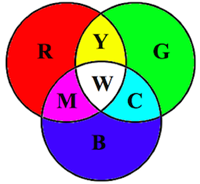 Many students of physics have seen a diagram similar to the one shown at the right. The diagram depicts three circles colored with the primary colors of light - red, green and blue. The primary colored circles overlap to produce other colors of light - known as the secondary colors of light: cyan, magenta and yellow. Complementary pairs of light colors are those colors that are exactly opposite each other on the diagram: red and cyan, magenta and green, and blue and yellow.
|